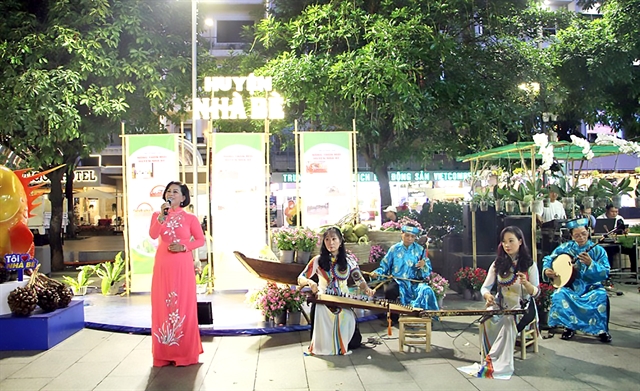HCM City art camp promotes tài tử performers
Culture - Ngày đăng : 09:54, 14/10/2024
 |
| PRESERVING ART: The HCM City Cultural Centre has organised a new art camp attracting many artists from 'tài tử' music clubs who have worked to preserve and keep the South’s traditional music alive. Photo courtesy of HCM City Centre of Culture. |
HCM CITY A new art camp that aims to preserve tài tử music (a genre of popular music in the South) has opened in the HCM City Cultural Centre and will run to October 18.
It is organised by the Cultural Centre and is part of the municipal authorities’ efforts to keep traditional genres of Southern theatre alive.
The camp has attracted 80 young and veteran artists from local theatres and art clubs.
It is focused on giving financial support to help tài tử performers develop their art.
The artists are encouraged to create new songs and music pieces in topics such as life, love, the country and HCM City.
Outdoor performances are also offered.
 |
| PRESERVING ART: The HCM City Cultural Centre has organised a new art camp attracting many artists from 'tài tử' music clubs who have worked to preserve and keep the South’s traditional music alive. Photo courtesy of HCM City Centre of Culture. |
Tài tử music originated in southern Việt Nam more than 100 years ago. It is the prototype for vọng cổ (nostalgic tunes) and cải lương (reformed opera), which are often performed during festivals and special occasions in the Mekong Delta region.
The music is performed at traditional festivals, weddings and death anniversaries in the provinces of Cần Thơ, Vĩnh Long, Bạc Liêu, and Cà Mau.
One of the most popular tài tử songs is Dạ Cổ Hoài Lang (Night Drumbeats Cause Longing for Absent Husband), a work written in 1919 by well-known composer Cao Văn Lầu of Bạc Liêu.
The song tells of the love, anguish and pride of a young woman watching her husband fight for the country. It is performed in many drama plays and films.
In 2013, tài tử was recognised as an Intangible Cultural Heritage of Humanity by UNESCO.
HCM City has 84 tài tử clubs, attracting more than 1,220 members.
These clubs offer training courses on folk singing and tài tử music for several thousand children and young people, so that they can learn and understand more about the art.
They also offer training in traditional instruments used in tài tử, such as the kìm (two-stringed guitar), cò (vertical violin with two strings), tranh (16-chord zither), and bầu (monochord zither).
In recent years, the city has offered new projects to help tài tử clubs boost their operations and quality of their shows.
According to Meritorious Artist Hoàng Tấn of District 3’s Tài Tử Club, tài tử clubs attract professional artists who have tried to bring tài tử closer to youngsters and help them understand the role of traditional arts.
“My club’s members are working to build a special playground for youngsters and inspire the preservation of folk culture activities,” he said. VNS
